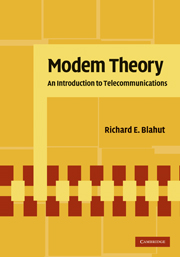Book contents
- Frontmatter
- Contents
- Preface
- Dedication
- 1 Introduction
- 2 Baseband Modulation
- 3 Baseband Demodulation
- 4 Sequences at Baseband
- 5 Passband Modulation
- 6 Passband Demodulation
- 7 Principles of Optimal Demodulation
- 8 Synchronization
- 9 Codes for Digital Modulation
- 10 Codes for Data Transmission
- 11 Performance of Practical Demodulators
- 12 Secure Communications
- Bibliography
- Index
12 - Secure Communications
Published online by Cambridge University Press: 05 June 2012
- Frontmatter
- Contents
- Preface
- Dedication
- 1 Introduction
- 2 Baseband Modulation
- 3 Baseband Demodulation
- 4 Sequences at Baseband
- 5 Passband Modulation
- 6 Passband Demodulation
- 7 Principles of Optimal Demodulation
- 8 Synchronization
- 9 Codes for Digital Modulation
- 10 Codes for Data Transmission
- 11 Performance of Practical Demodulators
- 12 Secure Communications
- Bibliography
- Index
Summary
The communication problem can be given a new dimension of complexity by the introduction of an adversary. The adversary may have a variety of goals. The goal may be to interrupt communication, to detect the occurrence of communication, to determine the specific message transmitted, or to determine the location or the identity of the transmitter. The communication problem now takes on aspects of the theory of games. The transmitter and receiver comprise one team while the adversary comprises the other team.
An adversary may try to interrupt communication by falsifying the messages or by inserting noise into the channel. In the former case, the adversary is called a spoofer while in the latter case, the adversary is called a jammer. An adversary who intends to read the specific message transmitted is called a cryptanalyst. An adversary who intends to determine the location or the identity of the transmitter or to detect the occurrence of communication is called a signal exploiter.
Waveform techniques to counter a jammer or an exploiter are similar; both try to spread the waveform over a wide bandwidth. Such waveforms are called antijam waveforms or antiexploitation waveforms. Techniques to counter a spoofer or a cryptanalyst tend to be similar: these may use a secret permutation on the set of messages to represent the actual message by a surrogate message formed in an agreed, invertible way based on a secret key.
- Type
- Chapter
- Information
- Modem TheoryAn Introduction to Telecommunications, pp. 453 - 478Publisher: Cambridge University PressPrint publication year: 2009



